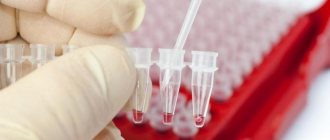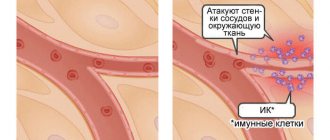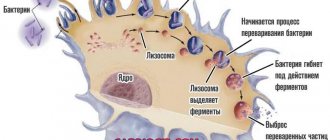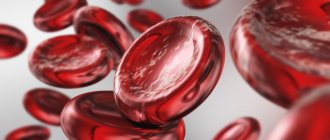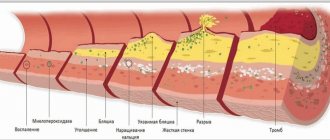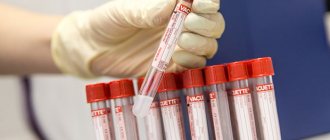Risk groups for high cholesterol
It has been proven that hypercholesterolemia occurs more often in people who:
- eat large amounts of animal fats;
- move little;
- are overweight;
- abuse alcohol;
- smoke;
- take certain medications for a long time (androgens, diuretics, glucocorticoids, cyclosporine, amiodarone, levodopa).
Men over 40 and women over 50 undergo a screening test for blood cholesterol (the norm is indicated in the tables above). It is one of the factors that is taken into account when calculating absolute cardiovascular risk.
Doctor's adviceNutrition for low cholesterol. You can eat any kind of porridge. If you have poor tolerance to milk protein, you can cook them with water, but it is better with half and half milk and water. There is little cholesterol in milk, especially store-bought milk, but the body needs protein. You can add 1/2 teaspoon of natural butter without vegetable fat to the finished porridge. You can eat this 2-3 times a week. On other days, the porridge should be seasoned with vegetable oil. Today, olive oil is considered the most beneficial in terms of cholesterol. You can also use regular sunflower, sea buckthorn, and camelina. Rapeseed should not be used. Salads should also be seasoned with butter or 10% sour cream instead of mayonnaise.
Victoria DruzhikinaNeurologist, Therapist
High and very high absolute risk means that in the coming years a person may suffer from severe and even fatal disorders of the heart and blood vessels.
Hypercholesterolemia is especially dangerous for people suffering from:
- coronary heart disease (therapy is carried out and advised by a cardiologist);
- atherosclerosis of the lower extremities;
- obesity;
- people prone to blood clots;
- chronic kidney diseases;
- hypertension;
- chronic kidney diseases;
- hypertension;
- diabetes mellitus (treated by an endocrinologist);
- collagenoses (for example, rheumatoid arthritis).
These conditions require frequent monitoring of lipids and drug correction if they increase.
When and why do you need to determine cholesterol in children and adolescents?
Chapter from the brochure by N.A.
Gratsiansky “Blood cholesterol, coronary heart disease, nutrition and some other “coronary” risk factors. When and why it is necessary to determine cholesterol in children and adolescents" Moscow - 2000. "Atherosclerosis - a pediatric nutrition problem"
“Atherosclerosis is a nutritional problem in childhood”
Russell L. Hollman. 1961.
Basic provisions
This part of the brochure is primarily intended for those people who at a young age (i.e. before 50-55 years old) suffered a myocardial infarction, suffer from angina pectoris, or who already at this age have had an increase in blood cholesterol levels. It will talk about what was only briefly mentioned earlier - about hereditary and/or family predisposition to the development of hypercholesterolemia (i.e., high cholesterol in the blood) and coronary heart disease, and, accordingly, the need to examine children of these “ prematurely" sick people. The last conclusion is based on three main points.
First position.
It is known that an increase in blood cholesterol is often found in close relatives. This is due to the same living conditions, the same diet of people living together. The reason may also be that people were raised together and, even living far from each other, retain the eating habits acquired in childhood.
But in some families, elevated cholesterol levels are definitely hereditary, caused by changes in a single gene. In such cases, they speak of the presence of a monogenic disorder. One of the most serious monogenic disorders is one that leads to a condition called familial hypercholesterolemia. If one of the parents has such a disorder in the genetic apparatus, then a significant increase in the level of cholesterol in the blood (hypercholesterolemia) will be observed in every second child. And 90% of these children (with high cholesterol) will develop coronary heart disease by age 65. The average adult man with familial hypercholesterolemia develops coronary heart disease by age 50.
Another inherited condition caused by a defect in one specific gene is familial combined hyperlipidemia. A person with this condition has an increase in blood levels of either cholesterol or other fatty substances called triglycerides, or both cholesterol and triglycerides at the same time.
Familial and familial combined hypercholesterolemia are relatively rare conditions. They appear quite early. In the most severe cases of familial hypercholesterolemia, when a child receives defective genes from both father and mother (such forms are called homozygous), a significant increase in cholesterol in the blood is detected in early childhood and even then can lead to the development of myocardial infarction.
The most common is polygenic hypercholesterolemia. It is caused by the action of several altered genes. Each of them has a small effect, contributing to a slight increase in blood cholesterol levels, but their combined effect leads to a significant increase in cholesterol (ie, hypercholesterolemia). It is especially important that the action of these genes is manifested under the influence of environmental factors, primarily when there is an excess amount of saturated fat and cholesterol in the daily diet. By changing these factors (for example, by normalizing the nature of nutrition), it is possible to ensure that the hereditary predisposition does not appear at all or appears only at a later age.
Most children and adolescents with high cholesterol have polygenic hypercholesterolemia and changes in lifestyle, in particular diet, can lead to normalization of cholesterol levels. We can say that in most of these cases there is a hereditary predisposition, but by no means a hereditary predetermination of hypercholesterolemia.
Second position
The early (before the age of 50-55 years) appearance of coronary heart disease - myocardial infarction, angina - is also very often due to a hereditary predisposition to this disease. It may be associated with inheritance of risk factors - high cholesterol, high blood pressure, diabetes, overweight (obesity). But the early onset of the disease is sometimes traced in one family, the members of which are not characterized by the presence of any one specific of these factors. The origin of the disease in these cases is also likely due to defects in several genes (polygenic). The effect of these altered genes is manifested in the presence of certain conditions (smoking, excess consumption of saturated fats, low physical activity, etc.) that can be eliminated by a person. Moreover, in order not to create conditions for the early manifestation of gene defects, a particularly active impact on the identified risk factors is necessary, in particular, a significant reduction in blood cholesterol levels.
Third starting position
This position justifies the advisability of early detection of hypercholesterolemia and other risk factors for atherosclerosis in children and adolescents. Atherosclerotic vasoconstriction develops slowly, gradually, and the first signs of atherosclerosis appear already in childhood and adolescence.
The earliest warning signs of atherosclerotic plaque in blood vessels are deposits of fat called fatty spots. It has been reliably established that fatty spots in the aorta appear already in childhood, fatty spots in the coronary arteries appear somewhat later, in adolescence. And real atherosclerotic plaques begin to form between the ages of 13 and 19 years.
Important information was provided by the PDAY study conducted in the USA - “Patobiological determinants of atherosclerosis in young people.” In people 15-34 years old who died from injuries, accidents, victims of murder and suicide, the blood levels of cholesterol and its “good” and “bad” fractions (i.e., low- and high-density lipoprotein cholesterol) were measured and the condition of the heart vessels was studied. (coronary arteries) and aorta. In these same people, the blood levels of thiocyanate were determined, a substance whose presence is a sign that a person smokes (i.e., a marker of smoking). The results obtained from 1079 men and 364 women were published. A positive (direct) relationship was found between the degree of atherosclerotic lesions in the aorta and coronary artery. and the level of “bad” low-density lipoprotein cholesterol in the blood. In addition, an inverse relationship was found between the severity of vascular changes and the level of “good” high-density lipoprotein cholesterol. People with high levels of “good” cholesterol, low levels of “bad” cholesterol and no evidence of smoking had no noticeable fatty (lipid) deposits in the arteries, while people with the opposite indicators of low HDL cholesterol, high LDL cholesterol and obvious smokers had pronounced fatty deposits in their arteries. sediments. It is especially important that the difference in the prevalence of early atherosclerotic changes in the coronary arteries in young people with a favorable and unfavorable profile of risk factors was detected already at the age of 15 years!
Next, it is appropriate to quote a phrase from the report of the expert committee on cholesterol levels in children and adolescents of the National Cholesterol Education Program in the USA. “There are many indications that initial atherosclerotic vascular lesions appear already in childhood and the appearance of these lesions is due to increased cholesterol levels in the blood.”
This evidence supports the view that efforts to prevent the onset or progression of atherosclerosis should begin in childhood or adolescence.
Another fact that was found in the PDAY study cannot be ignored: among people aged 25-34 years, smokers (according to the determination of thiocyanate) had 3 times (!) greater severity of atherosclerotic changes in the aorta than non-smokers.
Do all children need to have their blood cholesterol levels determined?
It is believed not. Although it is very common for children with high cholesterol to become adults with hypercholesterolemia, it is also common for blood cholesterol to normalize as they grow older.
According to the recommendations of the Expert Committee on Blood Cholesterol Levels in Children and Adolescents of the National Cholesterol Education Program in the United States, blood cholesterol levels must be determined in the following cases.
1. In those children and adolescents whose parents, grandparents have (or had) any signs of coronary heart disease, cerebral or peripheral vascular disease before the age of 55 years. These signs must first of all include a history of myocardial infarction and the presence of overt angina.
2. The child’s cholesterol level must be checked even if one of his parents at a young age (up to 50-55 years) has ever had elevated cholesterol (i.e. exceeding 240 mg/dl or 5.2 mmol /l).
What cholesterol level is considered “normal” and what is considered “high” in childhood and adolescence?
In children over 2 years of age or in adolescents in whom one of the parents has cholesterol exceeding 240 mg/dL (6.2 mmol/L) or in the family there are cases of “early”, i.e. If the father developed coronary heart disease (myocardial infarction, angina) before the age of 55, cholesterol levels are divided as shown in Table 6.
Table 6.
Characteristics of cholesterol levels in children and adolescents
Desirable (acceptable) - less than 170 mg/dL (4.4 mmol/L)
Borderline - 170-199 mg/dl (4.4 - 5.15 mmol/l)
High - 200 mg/dL (5.2 mmol/L) or more
Combinations of risk factors need to be identified.
As in adults, the borderline level takes on special significance and requires special intervention when the child or adolescent has other risk factors for coronary heart disease - high blood pressure, diabetes, obesity or excess weight, if he is physically inactive or if he has already started smoking . A particularly important risk factor, as has been repeatedly noted, is the presence of early (i.e., before the age of 50-55 years) developed heart disease in one or more close relatives. According to the theme of this brochure, it is expressed in everyone who is discussed in it. And the discovery in a child, in addition to this factor and hypercholesterolemia, of a third, or even more so a fourth, makes the situation especially dangerous.
From the above, it is clear that in all cases when it is advisable for a child or adolescent to determine blood cholesterol for the above reasons, it is necessary to simultaneously conduct a thorough examination to identify high blood pressure, signs of latent diabetes or a tendency towards it, and a tendency to obesity. Such an examination can reveal some combinations of risk factors that are dangerous for the early development of atherosclerosis in children without increasing the total cholesterol content in the blood. Thus, excess weight is often combined with high blood pressure, signs of latent diabetes and a decrease in high-density lipoprotein cholesterol ("good" cholesterol).
If hypercholesterolemia occurs in a child or adolescent, it is necessary to determine the levels of “good” and “bad” cholesterol.
Just like in adults, if a child’s cholesterol level turns out to be high or borderline, it is necessary to determine the levels of low- and high-density lipoprotein cholesterol, i.e. "bad" and "good" cholesterol. Knowing these indicators is very helpful in determining further tactics. In some cases, blood cholesterol is elevated due to its “good” part, i.e. high density lipoprotein cholesterol.
What to do if your child has high cholesterol.
When it is determined that a child who has relatives with premature (early) coronary heart disease, other atherosclerotic vascular diseases, or hypercholesterolemia has high cholesterol, it is necessary first of all to evaluate the nature of his diet and change it. The basic principle of this change is the same as when detecting hypercholesterolemia in an adult. It is necessary to limit the consumption of saturated fat, replacing it with unsaturated fat, and cholesterol (for more details, see the first section).
The diet of children of any age must contain the amount of calories, carbohydrates, proteins, fats, vitamins and minerals that meets the needs of a growing body. The diet recommended for normalizing blood cholesterol and preventing atherosclerosis fully meets this condition. What is required from the child is simply the usual proper nutrition of a healthy person.
But still, when planning a diet for children and adolescents, you should always remember the need to ensure a sufficient supply of calories (energy), protein and minerals. However, a diet low in saturated fat is not low in protein, calories or minerals.
The high caloric intake of food required by a growing body is provided by carbohydrates.
Lean meat and skim milk contain the same amount of protein as fat milk. Poultry and fish are rich in protein. There is a lot of it in carbohydrate foods - bread, cereals, pasta, rice, dried beans and peas.
There are many minerals, in particular calcium necessary for growth, in milk and dairy products. Therefore, your child should be taught to consume skim milk and products made from it very early. There is a lot of iron in lean “red” meat.
* * *
The National Cholesterol Education Program in the United States does not recommend suddenly changing the diet of a child or adolescent and immediately depriving him of foods rich in fats and cholesterol. It is considered advisable to replace one or two “harmful” dishes daily with diet-appropriate ones.
The nature of nutrition and lifestyle develop in the family
It is necessary to be well aware that the nutritional habits of parents influence and even determine the eating habits of children. Therefore, adults surrounding a child or adolescent in the family must constantly think about the example they set. Habits are formed very early. This is why it is so important to create common family eating habits - for example, the habit of consuming some raw vegetables, little salty foods, using vegetable oil, cereal porridges, skim milk products. Already in very early childhood, a child can learn and love the taste of fatty foods and sweets, and it will be extremely difficult to overcome this. Therefore, parents must do everything to make him fall in love with vegetables and fruits at this age. It is necessary that he prefers, for example, an orange to ice cream, a banana to “fashionable” Western candy, etc. (the cost of the fruit in these cases is less).
If a child is forced to adhere to a diet, to limit himself in some way, then foods that are undesirable for him simply should not be in the house.
You cannot demand that a child or teenager follow any rules of nutrition or behavior if you yourself do not comply with them (for example, you continue to smoke).
Stop smoking - if you have not already done this for yourself, you owe it to yourself to do so for the health of your son (or sons). It is your duty to do everything to ensure that he never starts smoking.
The example of parents is especially important because their children will have to overcome many extraneous influences - friends and acquaintances, radio and television, newspapers and magazines, cigarette advertising, sweets containing a lot of saturated fatty acids, etc.
* * *
The most important condition for normalizing blood lipids is the expansion of physical activity. Sports with fairly prolonged physical effort are advisable - running, cycling, various sports games (football, basketball, handball, badminton, or others with similar energy expenditure). A teenager should perform such physical exercises at least 3 times a week. In this case, the active participation of parents also helps a lot.
On the use of lipid-lowering drugs in children and adolescents.
When should the thought arise about the need to use special drugs that lower blood cholesterol (so-called hypocholesterolemic or hypolipidemic drugs)? It must be said that the use of such drugs in children is extremely undesirable and should be used only when the diet is clearly ineffective.
The Expert Committee on Cholesterol in Children and Adolescents in the United States has made the following recommendations. The use of medications should only be considered in children from 10 years of age (with the possible exception of rare cases of homozygous forms of familial hypercholesterolemia) after diet for at least 6 months has not achieved the desired result (i.e. has not led to a decrease in the level of low-density lipoprotein cholesterol less than 160 mg/dl or total cholesterol less than 235-240 mg/dl).
For children, even more so than for adults, the provision that the selection of medications that affect cholesterol levels should be carried out only in a specialized institution.
Table 7
In what cases is it necessary to determine blood cholesterol in children over 2 years of age?*
· When one of the parents or grandparents under 55 years of age has obvious (proven) coronary heart disease
· When one of the parents or grandparents under 55 years of age has obvious (proven) peripheral or cerebral vascular disease
· When one of the parents or grandparents is under 55 years of age, serum cholesterol exceeds 240 mg/dL
· When the child has other risk factors for coronary artery disease (coronary heart disease) - high blood pressure, diabetes, obesity
according to the recommendations of the National Cholesterol Education Program, USA (see II)
Blood cholesterol levels in men by age
| Age | Total cholesterol | LDL cholesterol | HDL cholesterol |
| < 5 years | 2.95-5.25 mmol/l | ||
| 5-10 years | 3.13-5.25 mmol/l | 1.63-3.34 mmol/l | 0.98-1.94 mmol/l |
| 10-15 years | 3.08-5.23 mmol/l | 1.66-3.34 mmol/l | 0.96-1.91 mmol/l |
| 15-20 years | 2.91-5.10 mmol/l | 1.61-3.37 mmol/l | 0.78-1.63 mmol/l |
| 20-25 years | 3.16-5.59 mmol/l | 1.71-3.81 mmol/l | 0.78-1.63 mmol/l |
| 25-30 years | 3.44-6.32 mmol/l | 1.81-4.27 mmol/l | 0.80-1.63 mmol/l |
| 30-35 years | 3.57-6.58 mmol/l | 2.02-4.79 mmol/l | 0.72-1.63 mmol/l |
| 35-40 years | 3.63-6.99 mmol/l | 1.94-4.45 mmol/l | 0.88-2.12 mmol/l |
| 40-45 years | 3.91-6.94 mmol/l | 2.25-4.82 mmol/l | 0.70-1.73 mmol/l |
| 45-50 years | 4.09-7.15 mmol/l | 2.51-5.23 mmol/l | 0.78-1.66 mmol/l |
| 50-55 years | 4.09-7.17 mmol/l | 2.31-5.10 mmol/l | 0.72-1.63 mmol/l |
| 55-60 years | 4.04-7.15 mmol/l | 2.28-5.26 mmol/l | 0.72-1.84 mmol/l |
| 60-65 years | 4.12-7.15 mmol/l | 2.15-5.44 mmol/l | 0.78-1.91 mmol/l |
| 65-70 years | 4.09-7.10 mmol/l | 2.49-5.34 mmol/l | 0.78-1.94 mmol/l |
| > 70 years | 3.73-6.86 mmol/l | 2.49-5.34 mmol/l | 0.85-1.94 mmol/l |
What is cholesterol
This is a type of lipid present in the structure of human and animal cells. 20% of it comes from food, and the bulk is synthesized by the body itself. At normal concentrations, this substance is not harmful, but even necessary, because it:
- strengthens cell membranes;
- promotes digestion;
- participates in the formation of sex hormones;
- stimulates the production of vitamin D;
- protects nerve fibers;
- reduces cell permeability.
Cholesterol is present in the body at any age. It is required for survival and cannot be replaced by anything. However, we often hear this substance mentioned in a negative context. This is a misconception, since only one type of it causes harm. It is important to distinguish them.
Causes of high and low cholesterol
In women and men over 40 years of age, excess cholesterol in the blood may be associated with genetic defects in lipid metabolism, but more often the cause remains unknown. Factors that contribute to increased blood cholesterol levels include:
- liver and gallbladder diseases;
- smoking;
- tumors of the pancreas, prostate gland;
- gout;
- chronic renal failure (the causes and treatment of kidney disease in women are described here);
- endocrine pathology (insufficient production of somatotropic hormone, diabetes mellitus, hypothyroidism).
In women, the cause of increased blood cholesterol compared to the norm can be pregnancy. Those who are planning to get pregnant after 40 need to know this.
Reduced lipid values are observed with:
- What are triglycerides, normal levels, reasons for the increase, how to reduce
- starvation, exhaustion;
- extensive burns;
- severe infections (treated by an infectious disease specialist);
- sepsis;
- malignant liver tumors (diagnosed and treated by an oncologist);
- some types of anemia;
- chronic lung diseases (read how to treat chronic bronchitis in this article);
- rheumatoid arthritis;
- hyperthyroidism.
Low blood lipid levels also occur in those who are vegetarians or take medications such as neomycin, thyroxine, ketoconazole, interferon, and estrogens.
Treatment and prevention
Today, high cholesterol in children is not uncommon. If this pathological condition is identified during an examination, the fight against it must begin as early as possible. Normalizing high cholesterol in children is somewhat easier than in adults. Before the onset of puberty, hypercholesterolemia can be easily corrected by normalizing the diet physical activity (race walking, running, swimming, cycling, skiing) to the daily routine
Forming healthy eating habits is an important task for parents.
Sometimes, if the above recommendations are followed, serum cholesterol levels do not decrease. Then the need for drug treatment arises and the question arises: “Can I take statins?” The instructions for drugs in this group state that they are contraindicated for children under 18 years of age due to the fact that there is no data on their safety and effectiveness in this age group.
Pediatricians recommend medicinal treatment of high cholesterol in children using the drug “Policonazole”. It is made from natural raw materials - sugar cane stalks. The medicine helps eliminate the imbalance between LDL and HDL and reduce total cholesterol levels. To achieve the desired result, taking Polyconazole must be combined with proper nutrition and physical activity.
Prevention of hypercholesterolemia involves maintaining a healthy lifestyle. This requires a diet and nutrition that contains a minimum of harmful fats. It is also necessary to monitor children’s body weight and teach them to systematically play sports. It should be remembered that the foundation for most diseases that occur in adulthood is laid in childhood!
Normal cholesterol levels in women
For an adult, healthy woman, normal levels are from 3.6 to 5.2 mmol/liter. If the values vary in the range of 5.2 -6.19 mmol/liter, cholesterol is considered moderately elevated. This is not a pathology yet, but it’s time to think about your diet and lifestyle. Indicators above 6.19 mmol/liter indicate that treatment should be started immediately.
The norm for bad cholesterol or LDL is considered to be no more than 3.5 mmol/liter. If the concentration of this compound exceeds 4.0 mmol/liter, then we can talk about high cholesterol. Normal healthy cholesterol should be from 0.9 to 1.9 mmol/liter. If it is below 0.78 mmol/liter, this condition is considered dangerous to the patient’s health.
The norms for different age groups are:
Cholesterol and its functions
Cholesterol is the substance of life. Alexander Yuryevich in his blog talks in detail about why it is needed, how “good” cholesterol differs from “bad”, which organs produce it, and also provides information on the metabolism of cholesterol in the body.
This substance performs the following functions:
- present in all metabolic processes;
- serves as a building material for cells, as it is contained in their membranes;
- helps produce myelin, which conducts nerve impulses;
- many hormones are also produced from cholesterol, especially sex hormones.
The body cannot live without cholesterol, since most biochemical processes are associated with cholesterol metabolism. From this we can conclude that the more active and better the metabolism, the higher the cholesterol level will be. If metabolism is disrupted, then cholesterol levels decrease.
Advice:
To understand in more detail what cholesterol is and why it is needed, watch other videos on Dr. Shishonin’s blog.
Join our community - Club of Former Hypertensive Patients
, download gymnastics, which has already helped hundreds of thousands of people overcome pressure surges and hypertension. Get the most current and correct information related to blood pressure, osteochondrosis, atherosclerosis, ask your questions to Dr. Shishonin and just communicate.

